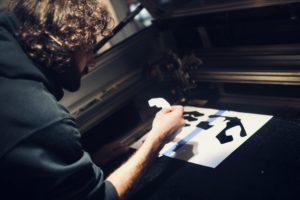The Pros and Cons of Precision Cutting Techniques
Metal fabrication involves the use of a wide variety of options for precision cutting of metal materials. The most common cutting options are water jet and laser cutting. Here is an in-depth look at the applications and the pros and cons of these two metal cutting options.
Water Jet Cutting
Water jet cutting involves the use of pressurized water with an abrasive such as garnet to cut material. With this method, a high-pressure pump is used to drive water through hoses causing a forceful water jet, hence the name water jet cutting. This metal cutting method is common because it can cut any material, including combination materials. Water jet cutting also handles a range of thickness that is greater than many cutting methods’ capabilities. ProfusionUSA uses this process for flat surfaces.
One main advantage of water jet cutting over laser cutting is edge finish. Laser cutting produces heat, which results in a heat-affected zone. This distorted zone requires a secondary finish. With water jet cutting, there is no heat-affected zone. The process does not damage any parts. Waterjet provides a smooth edge finish. This means there is no need for a secondary finishing process.
One of the downsides of this metal cutting technique is that it is time-consuming. Water jet cutting is also noisy and results in a big mess. A significant amount of waste is produced because of the mixture of water and an abrasive. This method will require a more laborious and costly cleanup and disposal process than laser cutting.
Laser Cutting

Laser cutting involves the use of a gas laser for energy. For example, a CO2 laser can be used. In this case, the CO2 is transmitted via a beam. This beam is guided by mirrors which direct it at the material. ProfusionUSA uses laser cutting with various materials, including glass, plastic, wood, and metals. However, this method is difficult to apply to a material combination, especially if the materials have different melting points.
Laser cutting does not require strict safety measures like water jet cutting. With the water jet cutting method, you will require ear protection because the process is very noisy. You will also need protection against the pressured water jet. Specific safety glasses, covers, and gears are used for protection.
The main precaution you need to take during laser cutting is to have proper ventilation. This will protect you from toxic dust and smoke. Laser cutting is less noisy, and after the process is complete, the machine does not need to be thoroughly cleaned since the cutting waste is dust, which can be easily vacuumed. However, the major downside with laser cutting is thermal stress that can impact heat-affected zones. The best way to prevent thermal stress cracking is by adjusting the speed of the cutting machine.
Laser cutting is highly renowned for its precision. This method is faster than water jet cutting. Laser cutting is also far cleaner than the water jet technique, which is quite costly in disposing of waste material. Laser cutting also supports a tolerance of within 0.002”. Laser cutting is best suited for tubes, squares, bars, and flat sheets.
In Conclusion
Water jet and laser cutting methods are one of the most common techniques in the metal fabrication industry. When choosing a metal cutting technique, a lot needs to be considered. You first need to consider the type of material you are cutting. Some methods do not work well with a combination of materials.
Other things you need to pay attention to include safety precautions, speed, and clean up services. Cutting techniques also vary in terms of the range of thickness, cut quality, and productivity. If you want quality cutting services by a seasoned and reputable firm, ProfusionUSA will not let you down. Reach out to us today and experience quality metal fabrication services.